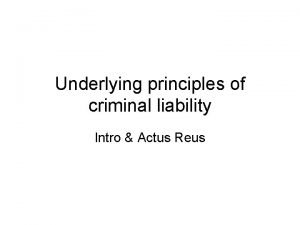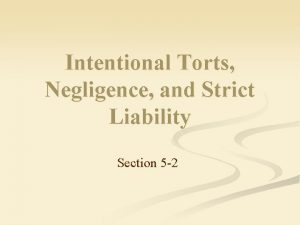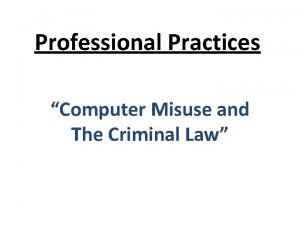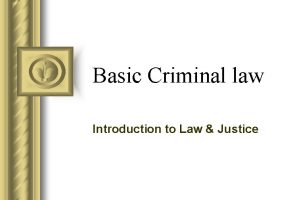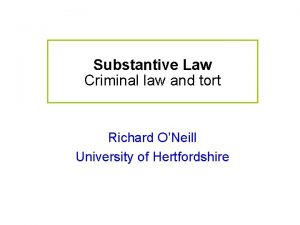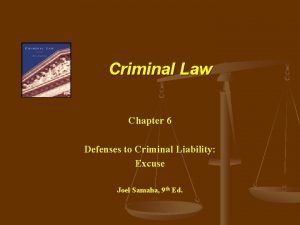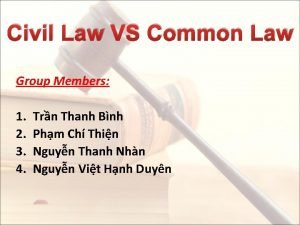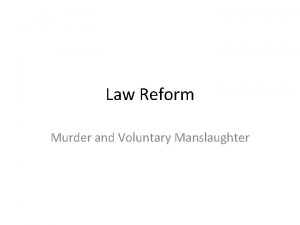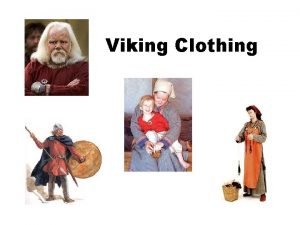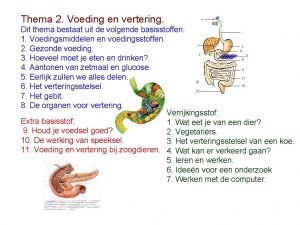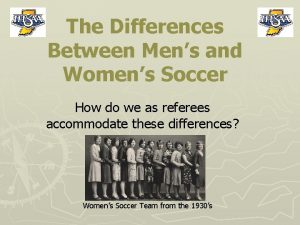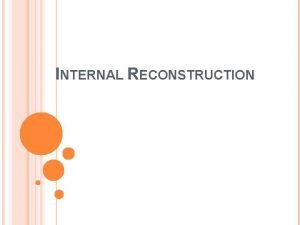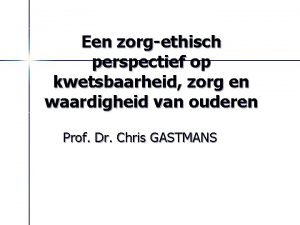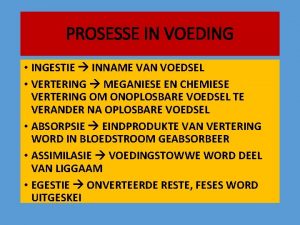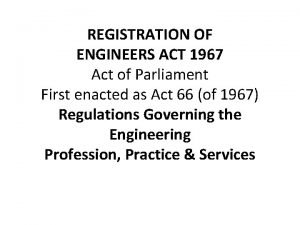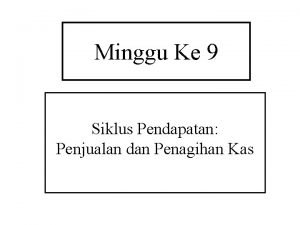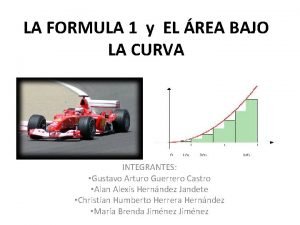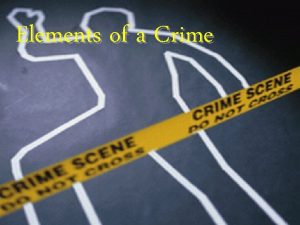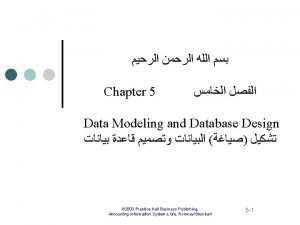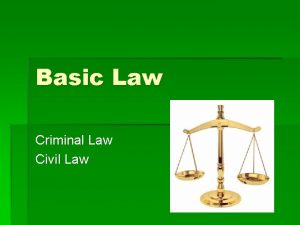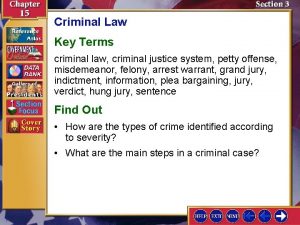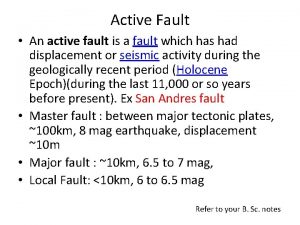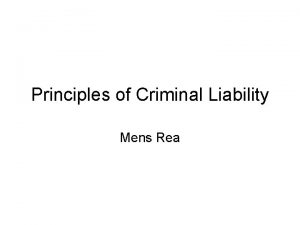Criminal law Chapter 05 MENS REA The fault




















































![Moloney [1985] • The defendant( D) was and V (D’s stepfather of whom D Moloney [1985] • The defendant( D) was and V (D’s stepfather of whom D](https://slidetodoc.com/presentation_image/592d9144839ad7bbd000fa3787390de5/image-53.jpg)







![Nedrick [ 1986] Nedrick [ 1986]](https://slidetodoc.com/presentation_image/592d9144839ad7bbd000fa3787390de5/image-61.jpg)

![Nedrick [ 1986] Facts similar to Hyam Nedrick [ 1986] Facts similar to Hyam](https://slidetodoc.com/presentation_image/592d9144839ad7bbd000fa3787390de5/image-63.jpg)
![Nedrick [ 1986] • Facts: - The defendant D poured paraffin through the letterbox Nedrick [ 1986] • Facts: - The defendant D poured paraffin through the letterbox](https://slidetodoc.com/presentation_image/592d9144839ad7bbd000fa3787390de5/image-64.jpg)




![Woolin [1998] Woolin [1998]](https://slidetodoc.com/presentation_image/592d9144839ad7bbd000fa3787390de5/image-69.jpg)
















![Cunningham [1957] (subjective/advertent recklessness) Cunningham [1957] (subjective/advertent recklessness)](https://slidetodoc.com/presentation_image/592d9144839ad7bbd000fa3787390de5/image-86.jpg)

![Cunningham [1957] (subjective recklessness- must be aware of the risk) • D went into Cunningham [1957] (subjective recklessness- must be aware of the risk) • D went into](https://slidetodoc.com/presentation_image/592d9144839ad7bbd000fa3787390de5/image-88.jpg)
![Cunningham [1957] (subjective recklessness- must be aware of the risk) • The term malicious Cunningham [1957] (subjective recklessness- must be aware of the risk) • The term malicious](https://slidetodoc.com/presentation_image/592d9144839ad7bbd000fa3787390de5/image-89.jpg)
![Cunningham [1957] (subjective recklessness- must be aware of the risk) • CA – the Cunningham [1957] (subjective recklessness- must be aware of the risk) • CA – the](https://slidetodoc.com/presentation_image/592d9144839ad7bbd000fa3787390de5/image-90.jpg)







![R v G [2003] • DD aged 11 and 12 went camping without their R v G [2003] • DD aged 11 and 12 went camping without their](https://slidetodoc.com/presentation_image/592d9144839ad7bbd000fa3787390de5/image-98.jpg)


![Mc. Crone v. Riding [1938] 1 All ER 137 • where it was held Mc. Crone v. Riding [1938] 1 All ER 137 • where it was held](https://slidetodoc.com/presentation_image/592d9144839ad7bbd000fa3787390de5/image-101.jpg)

















![Thabo Meli v The Queen [1954] 1 WLR 228 Single transaction rule D and Thabo Meli v The Queen [1954] 1 WLR 228 Single transaction rule D and](https://slidetodoc.com/presentation_image/592d9144839ad7bbd000fa3787390de5/image-119.jpg)
![Thabo Meli • Lord Reid: "[It is]. . . impossible to divide up what Thabo Meli • Lord Reid: "[It is]. . . impossible to divide up what](https://slidetodoc.com/presentation_image/592d9144839ad7bbd000fa3787390de5/image-120.jpg)



![Le Brun [1991] 4 All ER 673 • no antecedent plan and neither was Le Brun [1991] 4 All ER 673 • no antecedent plan and neither was](https://slidetodoc.com/presentation_image/592d9144839ad7bbd000fa3787390de5/image-124.jpg)















- Slides: 139

Criminal law Chapter -05

MENS REA- The fault element

Criminal liability Actus reus + Criminal mens rea + = Liability no defence

Mens rea criminal law’s filtering mechanism it ensures that Only the blameworthy are punished

Is mens rea = guilty Mind? • We are not interested whether the D feels guilty about his conduct or not

• The term criminal fault is wider than the term mens rea …………………. • Criminal fault= mens rea + negligence

There are two types of criminal fault 1. Objective fault and 2. Subjective fault.

Subjective & Objective

Subjective & Objective

There are two types of criminal fault 1. Objective fault and What would a reasonable person be thinking about 1. Subjective fault. What was going on in the defendants head

Objective fault • A person is objectively at fault if they are thought blameworthy, irrespective of their state of mind at the time of acting, because they failed to conform to an accepted standard of behaviour

Objective standards do not vary with the context and take no account of the intentions or beliefs of the defendant. Terms representing the ‘objective fault’ • Negligence or • carelessness

‘Objective fault’ and are the attributes of a person who fails to conform to the standards of ordinary, reasonable people. Examples of crimes of objective fault • careless driving • dangerous driving and • gross negligence manslaughter.

Argument against “objective fault” Argument in favour of “objective fault” objective fault should have It is fair to punish people little or no place in criminal who fail to live up to the law because of the standards of behaviour importance of desert in that we expect from punishment. ordinary, reasonable people, if they were doing their incompetent best Mc. Crone v Riding for example, the court ruled that it was no answer to a charge of careless driving that the driver was a learner driver and was not able to drive as proficiently as those who had passed their test. (1938)

Hart’s view about objective fault Accepts that punishment is deserved for failing to conform to objective standards of behaviour but nevertheless insists that punishment should be limited to those who would have had they put their mind to it. ( see page 41 of the subject guide)

Subjective fault Most serious crimes are crimes of subjective fault. e. g : - Murder Most of these crimes carry substantial custodial sentences Serious crimes but not crimes of subjective fault • Rape • Gross negligence manslaughter

• Considering its penal consequences citizens are protected by a general requirement that, when performing their act of wrongdoing, they have an accompanying mental attitude or mental element. It is this mental element (mens rea) which makes them blameworthy and so punishable. • In subjective fault desert in punishment requires the defendant to consciously choose the wrong they are about to perform whereas in the case of objective fault the defendant is at fault simply because they did something bad or stupid, and not because they consciously chose to do so.

subjective mental attitudes can take different forms offence Subjective mental attitude Murder Intention to kill/cause grievous bodily harm (serious injury) Theft The defendant knew others would think his actions are dishonest Criminal damage Damage/destruction was done intentionally/recklessly (with foresight)

Our syllabus subjective fault (mens rea) – namely intention and recklessness objective fault ( not mens rea) negligence.

INTENTION

Measuring criminal fault intention is the highest level of criminal fault intention recklessness negligence 0 1 2 3 4

INTENTION/SPECIFIC INTENTION • Often in Homicide cases • N. B: - mens rea is not only intention

Intention or mens rea is not Motitve Motive the reason why D did what he did Usually irrelevant Mens rea What the D meant to do

• INTENTION – CONNECTED WITH THE RESULT ELEMENT OF THE ACTUS REUS • KNOWLEDGE – CONNECTED WITH THE CIRCUMSTANCE ELEMENT OF THE ACTUS REUS

BASIC, SPECIFIC & ULTEROR INTENT CRIMES BASIC INTENT CRIMES It is not necessary to prove intention as part of proving the mens rea e. g. Criminal Damage * Also includes crimes of Negligence SPECIFIC INTENT CRIMES Nothing less than intention on the part of the defendant should be proved e. g. Murder ULTERIOR INTENT CRIMES It requires mens rea in relation to the consequence which goes beyond the actus reus of the offence e. g. Burglary contrary to s 9(1)(a) of the Theft Act. 1968 see page 58 & 59 of your subject guide

BASIC, SPECIFIC & ULTEROR INTENT CRIMES BASIC INTENT CRIMES SPECIFIC INTENT CRIMES not necessary to prove that D intended to do anything other than perform the acts which they did perform In Criminal Damage Has to prove D intended to light match stick Need not prove D intended to damage property Has to prove that D intended to bring about some state of affairs by doing what they did in murder Prosecution must always show that D acted with intention to kill or with the intention to cause GBH

• What is intention?

INTETNION • THE MENS REA OF MOST SERIOUS CRIMES

Murder by shooting Prosecution must prove • D intended to pull the trigger • D intended to kill or at least the defendant intended to cause GBH

What’s intention? Answer is important B’cos 1. helps to distinguish intention from other fault elements 2. Helps to distinguish crimes e. g. Murder & manslaughter ( murder is a specific intent crime)

• If I say I intend to go London tomorrow what does it mean?

If I say I intend to go London tomorrow what does it mean? • MY AIM is to go to London tomorrow • MY DESIRE is to go to London tomorrow ………………. . • If I succeed in going to London I have achieved my AIM , or DESIRE It would be correct to say At the time I went to London I also intended to go to London

Does the above slide cover intention? There are 4 House of Lords & Court of Appeal decisions on intention This is because intention means a little more than its plain meaning

2 types of intention Direct intention Indirect/oblique intention

Direct intention • If the Defendants aim /desire is to achieve a certain result and the defendant does something to achieve that result we can say that he intended that result It is John aim /purpose or desire to see that Sara dies. He shoots Sara dead . We can say that John intended to kill Sara

What about X who puts explodes a plane to destroy a cargo that is in the plane? Does he intend to kill the passengers?

Direct intention Net is small Only a few can be caught

Intention Direct intention – not enough Net should be widened

Oblique/indirect intention • Primary purpose /aim desire =to destroy cargo Cargo gets destroyed = he achieved his aim – so he intended to destroy cargo ( he has direct intention to destroy the cargo) • When he exploded the plane if he did not aim /desire that people on board should die ( he does not have direct intention to kill people)

Oblique/indirect intention • But when he exploded the plane if he could foresee that it is inevitable that ( virtually certain) that the people on board the plane would die or grievous bodily harm will be caused to them then the jury is justified in coming to a conclusion that he intended to kill /cause GBH to the passengers as well. ( D intended the whole package) ( This is Oblique intention)

Oblique/indirect intention • In all cases where he defendant can foresee death /GBH as virtually certain when the defendant tries to achieve his primary objective ( which is not to kill/ cause GBH ) should the jury decide that he intended to kill/cause GBH ? • Should they have a discretion?

Oblique/indirect intention • V is in hospital on a life support machine. Doctors have concluded that there is no prospect of recovery. X is admitted to the hospital following a car accident. X will die unless put on to a life support machine immediately, but there are none free. Y, X’s surgeon, removes the life support machine from V and gives it to X. Y knows that the inevitable result of this will be V’s death. Does Y intend to kill V? A jury will be very reluctant to Say Y intended to kill or intended cause GBH on V

Oblique/indirect intention • A person could be said to have oblique intention where , although a particular result is not his primary purpose or objective, he appreciates , as a virtual certainty, that result will occur as a consequence of his conduct. This is not a rule of substantive law but a rule of evidence. Jury has a discretion to come to a conclusion based on all the evidence Jury can say there is intention Jury can also say that here is no intention

Oblique/indirect intention • If the jury thinks that the D did not desire death/GBH but he saw death as highly probable but not virtually certain the defendant is only reckless • ( does not intend = no oblique intention)

Liability for criminal fault direct intention oblique intetntion recklessness negligence 0 2 4 6

The present law on oblique intention has developed through the courts • • • Hyam 1975 Moloney 1985 Hancock and Shankland 1986 Nedrick 1986 Woolin 1998 Mathews & Allenyne 2003

WITH ALL THESE CASES • STILL NO DEFINITION OF INTENTION

Hyam (1975)

Hyam’s case - came up for much criticism • D sought to frighten an occupant ( Mrs Booth ) of a house by pouring petrol though the letterbox and then igniting it, resulting in the death of two occupants by asphyxia.

Hyam At the trial At the appeal Hyam argued that she did not intend to kill or cause serious injury to Mrs Booth or the children: her intention was to frighten Mrs Booth. This argument was unsuccessful and Hyam was convicted. Upheld the conviction on the basis that since she acted in the knowledge that death or serious injury was likely she must be taken to have intended those consequences

• Hyam was subject to much criticism

The cases of Moloney & Hancock and Shankland Moloney Hancock and Shankland
![Moloney 1985 The defendant D was and V Ds stepfather of whom D Moloney [1985] • The defendant( D) was and V (D’s stepfather of whom D](https://slidetodoc.com/presentation_image/592d9144839ad7bbd000fa3787390de5/image-53.jpg)
Moloney [1985] • The defendant( D) was and V (D’s stepfather of whom D was very fond) had a contest as to loading and firing a shotgun. D a serving soldier shot V without aiming. V taunted D to fire the gun. Incident occurred during a late night of drinking. The defendant was found not guilty of murder.

Hancock and Shankland In the midst of a miner’s strike in which they were participating, H and S pushed a concrete block and post from a bridge over the road along which V was driving M; the latter was killed in the collision

• In the cases of Moloney and Hancock and Shankland, the House of Lords revisited the meaning of intention. Although both these cases are cases on murder the conclusions that the HL came to in them hold good for all crimes of specific intent

Moloney Guidelines Lord Bridge The following 2 questions should be placed before the jury • Was death or really serious injury in a murder case (or whatever relevant consequence that must be proved to have been intended in any other case) a natural consequence of the defendant’s voluntary act? • Did the defendant foresee that consequence as being a natural consequence of his act? If the jury answers both questions in the affirmative, it is a proper inference for them to draw that he intended that consequence

In Moloney & Hancock • HLs, disapproving Hyam, stated that foresight of probability, or even high probability, was not intention as a matter of definition.

• However, if the defendant did foresee a consequence as probable and yet carried on regardless, this was evidence fit to put to the jury that the consequence was in fact intended.

• The higher the degree of probability foreseen by the defendant, the more likely it was that the consequence was intended.

• Indeed, if the evidence showed that D foresaw the consequence as virtually certain, the inference that they intended it might be ‘irresistible’.
![Nedrick 1986 Nedrick [ 1986]](https://slidetodoc.com/presentation_image/592d9144839ad7bbd000fa3787390de5/image-61.jpg)
Nedrick [ 1986]

OBLIQUE INTENTION/INDIRECT INTENTION • A person could be said to have oblique intention where , although a particular result is not his primary purpose or objective, he appreciates , as a virtual certainty, that result will occur as a consequence of his conduct.
![Nedrick 1986 Facts similar to Hyam Nedrick [ 1986] Facts similar to Hyam](https://slidetodoc.com/presentation_image/592d9144839ad7bbd000fa3787390de5/image-63.jpg)
Nedrick [ 1986] Facts similar to Hyam
![Nedrick 1986 Facts The defendant D poured paraffin through the letterbox Nedrick [ 1986] • Facts: - The defendant D poured paraffin through the letterbox](https://slidetodoc.com/presentation_image/592d9144839ad7bbd000fa3787390de5/image-64.jpg)
Nedrick [ 1986] • Facts: - The defendant D poured paraffin through the letterbox of a house and set it alight, resulting in the death of a child. • Where a person realises that it is for all practical purposes inevitable that his actions will result in death or serious harm, the inference may be irresistible that he intended that result, however little he may have desired or wished it to happen.

• When the jury deliberates to make a decision on whether the consequence was intended they should do so by reference to all the evidence, and not just the probability of the consequence occurring.

Section 8 of the Criminal Justice Act 1967 • The jury shall not be bound in law to infer that he intended or foresaw a result of his actions by reason only of its being a natural and probable consequence of those actions. • It should instead make the decision about whether D did have such an intention or foresight: by reference to all the evidence and drawing such inferences from the evidence as appear proper in the circumstances.

• the jury will normally find it difficult (because the evidence of intention is so strong) to resist finding that D did intend the consequence, even though it may not have been their primary purpose.

D rapes V, a four-year-old infant. D then throws V into a fast-flowing river in order to destroy any trace of his DNA. He knows that this will certainly, for all practical purposes, result in V’s death, which it does. D does not act for the purpose of killing but the jury will nevertheless find it difficult, if not impossible, to conclude that he did not intend to kill V because he knew that this was inevitable and yet did nothing to stop it. If D did not intend the death of V then why did he do what he did? He intended, in other words, the whole package.
![Woolin 1998 Woolin [1998]](https://slidetodoc.com/presentation_image/592d9144839ad7bbd000fa3787390de5/image-69.jpg)
Woolin [1998]

At the trial • The prosecution accepted that Woollin did not act in order to kill or cause serious injury, but nevertheless argued that he intended at least serious injury. Woollin was convicted of murder. • At the trial judge had directed the jury that: • If they were satisfied that the appellant ’must have realized and appreciated when he threw that child that there was a substantial risk that he would cause serious injury to it, then it would be open to you to find that he intended to cause injury to the child and you should convict him of murder’.

At the appeal • The House of Lords made two very important points. 1. in the vast majority of cases the jury should not be directed by the judge as to what intention means since it is an everyday word. The jury should be directed simply that it should find the defendant not guilty of murder unless it was sure he intended to kill or, if not to kill, then to cause grievous bodily harm (the simple direction). However, it must be explained to the jury that intention is not the same as motive.

At the appeal • The House of Lords made two very important points. 2. The jury should be given some guidance in those rare cases, such as in this case Woollin and in above, where, although the evidence does not indicate a purpose to kill or cause grievous bodily harm it does indicate that the defendant was aware that death or grievous bodily harm might well occur

intention • Is a term that has an ordinary meaning • The jury should be encouraged to decide intention based on its meaning at the corresponding time • Only in exceptional case that the jury should be given guidelines

• Jury must take all the evidence into consideration • Woolin gives the judges some discretion • Very relevant since motive is irrelevant

Woolin • Draws a distinction between intention and recklessness • Foresight of anything less than virtual certainty cannot be intention but can only be recklessness

Woolin • Lord Steyn’s criticism of the trial judges finding • The judge should not have departed from the Nedrick direction. • By using the phrase “substantial risk” the judge blurred the line between intention and recklessness and hence between murder and Manslaughter The misdirection enlarged the scope of the mental element required for murder • The Nedrick test is Simple and clear. ( It was a time tested formula) judges should continue to use it. • It would be better to substitute the words “ to find” in place of “ to infer “ in the Moloney guidelines

Point to ponder • Can a terrorist who set s a bomb be convicted for the death of a member of the bomb disposal team according to the above reasoning of Lord Steyn?

Mathews and Alleyene • D threw a person who cannot swim to a river • Confirms foresight of virtually certainty is not intention but evidence from which the jury is entitled to infer intention

Intention – Law Commision’s suggested definition • A person acts (a) intentionally with respect to a result when; (i) It is his purpose to cause it, or (ii) Although it is not his purpose to cause it, he knows that it would occur in the ordinary course of events if he were to succeed in his purpose of causing some other result

Duff – see page 44 of the SG • Direct intention is the state of mind of someone who when acting would consider his act a failure if the consequence did not result.

RECKLESSNESS “ I DON’T CARE I AM DOING IT”

RECKLESSNESS A “TECHNICAL TERM” MEANING SETTLED ONLY IN 2003

RECKLESSNESS Recklessness is unjustified risk taking • D knows that he is taking a risk ( subjective) • Risk is unjustified ( objective) • D goes ahead with the risk A driver who gets a thrill by driving over 150 km/h Ambulance driver driving at over 150 km/h to reach a hospital to save the life of a patient Are the above risks justified?

RECKLESSNESS • The defendant knows that here is a risk that a consequence may result from his conduct, or that a relevant circumstance may exist, he takes that risk and it is unreasonable for him to do so having regard to the degree and the nature of the risk which he knows to be present

Recklessness is different from Negligence Recklessness Negligence Subjective fault Requires proof of awareness or thought Objective fault proof of awareness or though t is not required In Willful blindness these terms may overlap
![Cunningham 1957 subjectiveadvertent recklessness Cunningham [1957] (subjective/advertent recklessness)](https://slidetodoc.com/presentation_image/592d9144839ad7bbd000fa3787390de5/image-86.jpg)
Cunningham [1957] (subjective/advertent recklessness)

Types of Recklessness 1. Subjective/advertent recklessness ( Cunnigham recklessness) 1. Objective /inadvertent recklessness ( Caldwell recklessness)
![Cunningham 1957 subjective recklessness must be aware of the risk D went into Cunningham [1957] (subjective recklessness- must be aware of the risk) • D went into](https://slidetodoc.com/presentation_image/592d9144839ad7bbd000fa3787390de5/image-88.jpg)
Cunningham [1957] (subjective recklessness- must be aware of the risk) • D went into the cellar of an house that was converted into two. He tore the gas meter from the wall and from its pipes and stole money from it. He did not turn off the gas at a stop tap nearby and gas escaped, seeped through the dividing wall of the cellar and partially asphyxiated his prospective mother-in-law, who was asleep in her bedroom. • D was charged, with having unlawfully and maliciously caused W to take a certain noxious thing, coal gas, so as thereby to endanger her life.
![Cunningham 1957 subjective recklessness must be aware of the risk The term malicious Cunningham [1957] (subjective recklessness- must be aware of the risk) • The term malicious](https://slidetodoc.com/presentation_image/592d9144839ad7bbd000fa3787390de5/image-89.jpg)
Cunningham [1957] (subjective recklessness- must be aware of the risk) • The term malicious is used ins 23 of the OAPA- ( the offence with which D was charged) • Malicious does not mean wicked. • CA – the correct meaning is the one propounded by Prof Kenny ( see page 44 of the SG)
![Cunningham 1957 subjective recklessness must be aware of the risk CA the Cunningham [1957] (subjective recklessness- must be aware of the risk) • CA – the](https://slidetodoc.com/presentation_image/592d9144839ad7bbd000fa3787390de5/image-90.jpg)
Cunningham [1957] (subjective recklessness- must be aware of the risk) • CA – the correct meaning is the one propounded by Prof Kenny • Malicious means intention or recklessness • Recklessness means • The D has foreseen that the particular harm might be done and has gone onto take the risk of it

Being aware of the risk-does not always require conscious thought • Prof Kenny says forseeing the risk. • It may be better to put it as ‘ being aware of” • This is b’cos one can be aware of things which might happen without explicitly thinking about them ( forseeing them) at the time of acting)

Willful blindness “Closing ones mind to the obvious”

Willful blindness “Closing ones mind to the obvious” You are aware but don’t like to think about it See R v parker – page 44 SG

Is Cunningham fair • Is it that we ought to think of the risks to be reckless • What about a situation where A person thinks about his girlfriend while driving and meets with an accident b’cos he was not concentrating on the driving? Lord diplock developed objective recklessness to deal with situations like this

Caldwell (1982) Objective/inadvertent recklessness (1982 -2003) • D set fire by night to a residential hotel where he had been employed. He bore a grudge against the proprietor. According to his evidence he was so drunk at the time that it did not occur to him that there might be people there whose lives might be endangered. Held: Recklessness in the context of Criminal Damage does not require subjective appreciation of the risk of causing damage, but is also satisfied by a failure to consider an obvious risk.

Caldwell- Lord Diplock • Must include those who fails to foresee an obvious and serious risk

R v G ( 2003)
![R v G 2003 DD aged 11 and 12 went camping without their R v G [2003] • DD aged 11 and 12 went camping without their](https://slidetodoc.com/presentation_image/592d9144839ad7bbd000fa3787390de5/image-98.jpg)
R v G [2003] • DD aged 11 and 12 went camping without their parents approval. They went to the back of the Co-op in Newport Pagnell, lit some newspapers which set fire to a wheelie-bin which set fire to the shop, cause £ 1 m of damage. They were convicted of arson by a jury. Both the judge and jury appear to have been not content with applying the objective approach that the law required in R v Caldwell (1982) HL.

NEGLIGENCE

Negligence • The defendant is negligent if 1. Is unaware of the risk in question but ought to have been aware of it OR 2. Having foreseen it he does take steps to avoid it but those steps fall below the standard of conduct which would be expected of a reasonable person AN OBJECTIVE STANDARD IS REQUIRED
![Mc Crone v Riding 1938 1 All ER 137 where it was held Mc. Crone v. Riding [1938] 1 All ER 137 • where it was held](https://slidetodoc.com/presentation_image/592d9144839ad7bbd000fa3787390de5/image-101.jpg)
Mc. Crone v. Riding [1938] 1 All ER 137 • where it was held that a learner driver must meet the standard of a qualified driver

Negligence • Law Commission's definition Negligence occurs where a person fails to exercise such care , skill or foresight as a reasonable man in his situation would exercise • Shows how wide negligence is

Negligence • Negligence & gross negligence manslaughter • Negligence and Careless Driving and Dangerous Driving • Negligence & Rape • Negligence and s 28 of the Misuse of Drugs Act 1971 See page 49 of the subject guide for a discussion

Chapter 6 COINCIDENCE OF ACTUS REUS AND MENS REA

Actus reus & Mens rea In realtion to any given crime, actus reus and mens rea should in principle , coincide This means 2 things

• 1. actus reus and mens rea should coincide in point of time ( temporal coincidence) • 2. offence definitions should match any relevant conduct ( correspondence principle)

Temporal coincidence • Illustration 01 A takes V’s wallet, intending to steal from it. A few seconds later he changes his mind and puts the wallet back. • Illustration 02 D is a contract killer, with a contract to kill V. He drives to V’s house with his gun. On the way there D is involved in an accident when a pedestrian unexpectedly runs out in front of his car. The pedestrian is killed. D gets out of his car to discover the victim is V. D rubs his hands, pleased that he has been saved some effort. Is D guilty of murder?

Temporal coincidence • Illustration 01 A takes V’s wallet, intending to steal from it. A few seconds later he changes his mind and puts the wallet back. ( There is coincidence of actus reus and mens rea in time) • Illustration 02 D is a contract killer, with a contract to kill V. He drives to V’s house with his gun. On the way there D is involved in an accident when a pedestrian unexpectedly runs out in front of his car. The pedestrian is killed. D gets out of his car to discover the victim is V. D rubs his hands, pleased that he has been saved some effort. Is D guilty of murder? ( Actus reus and mens rea do not coincide in time)

Avoiding the coincidence requirement • If an act and mind does not coincide in time it is not always fatal to a successful prosecution

Qualifications • to the rule that actus reus and the mens rea must coincide • In this context Qualifications mean – ways of avoiding a rule

It may be possible to ignore the initial act and graft liability to a subsequent omission Miller (1983) • Actus reus first & mens rea later? • But actus reus will be based upon D’s omission to put out the fire • Actus reus and mens rea coincided at the moment of D’s deciding not to put out the fire • Actus reus ( omission ) & mens rea ( reckless- omission)

Actus reus Beating the victim ( no actus reus Exposing the victim Down the cliff ( there is actus reus) Beating, rolling over the cliff , exposing him ( single transaction) (there is actus reus +Thabo Meli + Mens rea Criminal liability Intention to kill victim there is mens re a but no actus reus ( there is mens rea) + Didn’t know he was There is actus reus exposing the victim but no mens rea to death. Thought that the victim was already dead ( no mens rea) + Intention to kill at the time of beating (there is mens rea) There is both actus reus and mens rea

Miller Actus reus Mens rea Setting fire accidently (there is actus reus) Did it accidently No mens rea Not putting out the fire Reckless ( taken as the actus reus) ( there is mens rea)

Continuing Act doctrine • Fagan

Fagan Actus reus • Reversing g vehicle accidently (there is actus reus) Mens rea No mens rea Not taking the car when asked to There is mens rea do so by the cop ( An omission -cannot be the actus reus since the crime is An offence that cannot be committed by an omisssion) Reversing the vehicle ) + not taking the car Continuing act( actus reus) Mens rea

Continuing Act & the mens rea • Where the actus reus of an offence can consist of a continuing act then, provided the defendant had the mens rea for the offence at some time during its continuance, there will be coincidence of actus reus and mens rea (Fagan v MPC [1969]).

rule = actus reus and mens rea must coincide in time • Exceptions

Exceptions to the rule Supposed corpse cases • D has attacked V and wrongly concluding that the victim is dead, disposed of the body, which disposal is the actual cause of death
![Thabo Meli v The Queen 1954 1 WLR 228 Single transaction rule D and Thabo Meli v The Queen [1954] 1 WLR 228 Single transaction rule D and](https://slidetodoc.com/presentation_image/592d9144839ad7bbd000fa3787390de5/image-119.jpg)
Thabo Meli v The Queen [1954] 1 WLR 228 Single transaction rule D and accomplices took V to a hut and beat him over the head intending to kill him. They rolled his body over a cliff to make the death appear accidental. In fact, the victim survived both the beating and the fall from the cliff, but died from exposure shortly afterwards. Held: Actus and mens were present throughout; no need to separate them, there was a causal link. Where the actus reus consists of a series of linked acts, it is enough that the mens rea existed at some time during that series, even if not necessarily at the time of the particular act which caused the death.
![Thabo Meli Lord Reid It is impossible to divide up what Thabo Meli • Lord Reid: "[It is]. . . impossible to divide up what](https://slidetodoc.com/presentation_image/592d9144839ad7bbd000fa3787390de5/image-120.jpg)
Thabo Meli • Lord Reid: "[It is]. . . impossible to divide up what was really one series of acts in this way. There is no doubt that the accused set out to do all these acts in order to achieve their plan, and as parts of their plan; and it is much too refined a ground of judgment to say that, because they were under a misapprehension at one stage and thought that their guilty purpose had been achieved before, in fact, it was achieved, therefore they are to escape the penalties of the law. " • D was found Guilty of murder

Actus reus Beating the victim ( no actus reus Exposing the victim Down the cliff ( there is actus reus) Beating, rolling over the cliff , exposing him ( single transaction) (there is actus reus +Thabo Meli + Mens rea Criminal liability Intention to kill victim there is mens re a but no actus reus ( there is mens rea) + Didn’t know he was There is actus reus exposing the victim but no mens rea to death. Thought that the victim was already dead ( no mens rea) + Intention to kill at the time of beating (there is mens rea) There is both actus reus and mens rea

Church • D took V (a married woman) to a van for sexual purposes. V mocked D and slapped him D knocked V unconscious. Unable to revive her he panicked and threw her into a river. V drowned. Held: D's conduct amounted to a series of acts, which culminated in her death and thus constituted manslaughter. ( none of the acts are capable of braking the chain of causation)

Church contd Edmund Davies: • 'an unlawful act causing the death of another cannot, simply because it is an unlawful act, render a manslaughter verdict inevitable. For such a verdict inexorably to follow, the unlawful act must be such as all sober and reasonable people would inevitably recognise must subject the other person to, at least, the risk of some harm resulting therefrom, albeit not serious harm. ' ”A grosser case of criminal negligence it would be difficult to imagine. ” • D was found guilty of Guilty of manslaughter.
![Le Brun 1991 4 All ER 673 no antecedent plan and neither was Le Brun [1991] 4 All ER 673 • no antecedent plan and neither was](https://slidetodoc.com/presentation_image/592d9144839ad7bbd000fa3787390de5/image-124.jpg)
Le Brun [1991] 4 All ER 673 • no antecedent plan and neither was there a belief on the part of the defendant that he was disposing of a corpse.

Le brun • D knocked his wife unconscious. He dragged her away to avoid detection, whist dragging her she hit her head on the kerb fracturing her skull, and she died. Held: The original unlawful act with its accompanying mens rea was not the direct cause of death, but the unlawful act and the act causing death were part of "the same sequence of events", and that was sufficient. Guilty manslaughter

UOL Audio presentation

Correspondence principle • Simply put, the correspondence principle requires a corresponding mental element for each aspect of the actus reus; that is, conduct, circumstance and consequence. The principle derives from the broader ethical principle that conviction and punishment be deserved. If a person can be punished for doing X without a mental element corresponding to X, then the punishment is undeserved and unfair.

• The correspondence principle is an ethical or normative principle rather than a descriptive principle. In practice, a good many crimes can be committed without a perfect match between actus reus and mens rea. Indeed, the majority of crimes of violence bear an actus reus without a corresponding mental attitude. Murder is a prime example.

Transferred malice • A man, intent on suicide, jumps from the ninth floor of his apartment block. Unknown to him, his wife is on the floor below, having a heated quarrel with her son. She draws a gun and fires at the son, intending to kill him. She misses, the bullet flies out of the window and hits - and kills - her descending husband. Is she guilty of murder? • This was a real US case, I'm told. The answer: Yes, if you mean to kill A and kill B instead, it's murder, even if B was going to die anyway in a few seconds. I feel sorry for B, clearly wanting to be a suicide, instead of a murder statistic.

• No breach of the correspondence principle occurs if the defendant commits the formal actus reus of an offence with the relevant mens rea for that offence, but the subject matter of that actus reus was other than that intended or foreseen by the defendant.

Intended subject matter Killing A ( no Actus reus) Achieved subject matter Killed B ( there is actus reus ) Intention to kill A ( there is mens rea) No intention to kill B ( no mens rea)

Intended subject matter Killing A ( no Actus reus) Achieved subject matter Killed B ( actus reus) Intention to kill A ( there is mens rea) Intention to kill A is transferred towards B (Mens rea)

Latimer (1886) Coleridge CJ stated: • It is common knowledge that a man who has an unlawful and malicious intent against another, and in attempting to carry it out, injures a third person, is guilty of what the law deems malice against the person injured, because the offender is doing an unlawful act, and has that which the judges call general malice, and that is enough.

Principle applies only to crimes of the same family • Malice’ will not be transferred where the actus reus achieved is not that which was intended. The actus reus and mens rea must coincide. So, where A shoots at B intending to kill B but misses his target, but the bullet breaks a window the ‘malice’ will not be transferred. • Pembiliton (1874)

Intended subject matter Intention to kill A Killing A ( there is mens rea) ( no Actus reus) Achieved subject matter No intention or Breaking a window recklessness to break the window ( there is actus reus ) ( no mens rea)

Actus reus is for murder mens rea is for criminal damage Intended subject matter Intention to kill A Killing A ( there is mens rea) ( no Actus reus) Achieved subject matter Intention to kill A Breaking a window cannot be transferred towards an intention or recklessness to break the window ( there is actus reus ) ( no mens rea)

• The principle of transferred malice is relevant in respect of any defences available to a defendant.

• doctrine of transferred malice may also apply in the case of an accomplice, provided the offence achieved by the principal offender is one to which the doctrine is capable of applying.

• If actus reus happens first – try continuing act • If mens rea happens first try single transaction principle
 Mens rea and actus rea
Mens rea and actus rea Nedrick (1986)
Nedrick (1986) Rea elke
Rea elke Mens rea
Mens rea Battery mens rea
Battery mens rea Pittwood 1902
Pittwood 1902 Mens rea adalah
Mens rea adalah Mens rea ελληνικα
Mens rea ελληνικα Strict liability crimes
Strict liability crimes Mens rea
Mens rea Difference between civil law and criminal law
Difference between civil law and criminal law Criminal law plaintiff
Criminal law plaintiff Computer misuse and criminal law
Computer misuse and criminal law Concurrence in criminal law
Concurrence in criminal law Example of criminal law
Example of criminal law Chapter 11 basic concepts street law
Chapter 11 basic concepts street law General defences in tort
General defences in tort M'naghten test elements
M'naghten test elements Difference between civil and criminal law table
Difference between civil and criminal law table Difference between civil and criminal law table
Difference between civil and criminal law table Define substantive criminal law
Define substantive criminal law Example of voluntary manslaughter
Example of voluntary manslaughter Causation in criminal law
Causation in criminal law Diminished responsibility in criminal law
Diminished responsibility in criminal law Law and order vs csi
Law and order vs csi Newton's first law and second law and third law
Newton's first law and second law and third law Newton's first law
Newton's first law Boyles law
Boyles law Charles law constant
Charles law constant Thermosensoren lichaam
Thermosensoren lichaam Mens shed insurance
Mens shed insurance 7 levensfasen mens
7 levensfasen mens Lux, lucis latino declinazione
Lux, lucis latino declinazione Mens shed dunsborough
Mens shed dunsborough Mens impletur gratia
Mens impletur gratia Narnia half mens half geit
Narnia half mens half geit Viking wool cloak
Viking wool cloak Restvolume longen
Restvolume longen Voortplanting mens
Voortplanting mens Tandformule mens
Tandformule mens Van baby tot bejaarde
Van baby tot bejaarde Mens dana in corpore sano
Mens dana in corpore sano Mijn wens voor ieder mens
Mijn wens voor ieder mens Thorn slimste mens
Thorn slimste mens Ieder mens draagt in zijn leven een onzichtbare rugzak mee
Ieder mens draagt in zijn leven een onzichtbare rugzak mee Stamboom evolutie mens
Stamboom evolutie mens Hartregulatiecentrum
Hartregulatiecentrum Exclusive jeans
Exclusive jeans Hoe maak 'n mens
Hoe maak 'n mens Tandformule varken
Tandformule varken Difference between mens and womens soccer
Difference between mens and womens soccer Peter synders
Peter synders Internal reconstruction
Internal reconstruction Men's shed insurance
Men's shed insurance Een mens
Een mens No mens
No mens Zorgethiek
Zorgethiek Kleur ontlasting
Kleur ontlasting Hoe maak mens
Hoe maak mens Woodworkforums
Woodworkforums De mens wordt vrij geboren maar verblijft overal in ketenen
De mens wordt vrij geboren maar verblijft overal in ketenen Warmbloedig mens
Warmbloedig mens Mens tunic shirt
Mens tunic shirt Farinks
Farinks Maribus latino
Maribus latino Centrum voor mens en luchtvaart
Centrum voor mens en luchtvaart Mens dana in corpore sano
Mens dana in corpore sano Girls lacrosse helmets
Girls lacrosse helmets Normale lichaamstemperatuur mens
Normale lichaamstemperatuur mens Hoeveel bloed heeft een mens
Hoeveel bloed heeft een mens Hình ảnh bộ gõ cơ thể búng tay
Hình ảnh bộ gõ cơ thể búng tay Ng-html
Ng-html Bổ thể
Bổ thể Tỉ lệ cơ thể trẻ em
Tỉ lệ cơ thể trẻ em Voi kéo gỗ như thế nào
Voi kéo gỗ như thế nào Chụp tư thế worms-breton
Chụp tư thế worms-breton Hát lên người ơi alleluia
Hát lên người ơi alleluia Các môn thể thao bắt đầu bằng từ đua
Các môn thể thao bắt đầu bằng từ đua Thế nào là hệ số cao nhất
Thế nào là hệ số cao nhất Các châu lục và đại dương trên thế giới
Các châu lục và đại dương trên thế giới Cong thức tính động năng
Cong thức tính động năng Trời xanh đây là của chúng ta thể thơ
Trời xanh đây là của chúng ta thể thơ Cách giải mật thư tọa độ
Cách giải mật thư tọa độ Phép trừ bù
Phép trừ bù Phản ứng thế ankan
Phản ứng thế ankan Các châu lục và đại dương trên thế giới
Các châu lục và đại dương trên thế giới Thể thơ truyền thống
Thể thơ truyền thống Quá trình desamine hóa có thể tạo ra
Quá trình desamine hóa có thể tạo ra Một số thể thơ truyền thống
Một số thể thơ truyền thống Cái miệng xinh xinh thế chỉ nói điều hay thôi
Cái miệng xinh xinh thế chỉ nói điều hay thôi Vẽ hình chiếu vuông góc của vật thể sau
Vẽ hình chiếu vuông góc của vật thể sau Nguyên nhân của sự mỏi cơ sinh 8
Nguyên nhân của sự mỏi cơ sinh 8 đặc điểm cơ thể của người tối cổ
đặc điểm cơ thể của người tối cổ Ví dụ về giọng cùng tên
Ví dụ về giọng cùng tên Vẽ hình chiếu đứng bằng cạnh của vật thể
Vẽ hình chiếu đứng bằng cạnh của vật thể Vẽ hình chiếu vuông góc của vật thể sau
Vẽ hình chiếu vuông góc của vật thể sau Thẻ vin
Thẻ vin đại từ thay thế
đại từ thay thế điện thế nghỉ
điện thế nghỉ Tư thế ngồi viết
Tư thế ngồi viết Diễn thế sinh thái là
Diễn thế sinh thái là Dot
Dot Số nguyên tố là
Số nguyên tố là Tư thế ngồi viết
Tư thế ngồi viết Lời thề hippocrates
Lời thề hippocrates Thiếu nhi thế giới liên hoan
Thiếu nhi thế giới liên hoan ưu thế lai là gì
ưu thế lai là gì Khi nào hổ con có thể sống độc lập
Khi nào hổ con có thể sống độc lập Khi nào hổ con có thể sống độc lập
Khi nào hổ con có thể sống độc lập Hệ hô hấp
Hệ hô hấp Từ ngữ thể hiện lòng nhân hậu
Từ ngữ thể hiện lòng nhân hậu Thế nào là mạng điện lắp đặt kiểu nổi
Thế nào là mạng điện lắp đặt kiểu nổi What is rea diagram
What is rea diagram Rea diagrams are especially useful
Rea diagrams are especially useful Engineers registration act
Engineers registration act Rea salud
Rea salud Alan rea
Alan rea Dua aktivitas utama dalam penagihan
Dua aktivitas utama dalam penagihan Rea formula
Rea formula Sua figlia
Sua figlia I rea
I rea Actus rea
Actus rea Scott rea
Scott rea Rea data model
Rea data model Risultato economico attualizzato
Risultato economico attualizzato Database design process
Database design process Rea model
Rea model Rea diagram expenditure cycle with cardinalities
Rea diagram expenditure cycle with cardinalities Rea model
Rea model Actis reus
Actis reus Rea silvia (jacopo della quercia)
Rea silvia (jacopo della quercia) Charly rea
Charly rea Rea bil
Rea bil E tipu e rea mo nga ra o to ao
E tipu e rea mo nga ra o to ao Diagram rea siklus produksi
Diagram rea siklus produksi Berikut adalah aktivitas siklus produksi
Berikut adalah aktivitas siklus produksi Que es el rea en finanzas
Que es el rea en finanzas Activity diagram siklus pengeluaran
Activity diagram siklus pengeluaran Diagram rea siklus produksi
Diagram rea siklus produksi Rea data model
Rea data model





